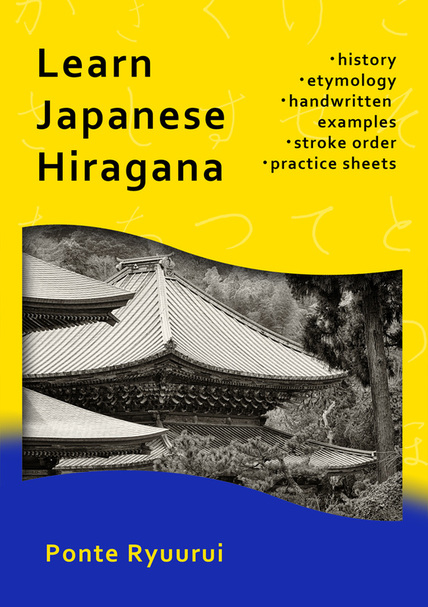 Officially published as of today! Learn Japanese Hiragana is one of three books on the subject of Japanese language and etymology that I have been working on for some time now. Although Learn Japanese Hiragana and Learn Japanese Katakana are separate and stand alone books, so it is possible to buy them as stand alone volumes. The most significant thing that distinguishes my books from any other hiragana and katakana textbooks out there, is that all and every single syllabary or a character was handwritten the way it should be. There is a huge discrepancy between a handwritten Japanese and computer fonts, and this subject is hugely neglected. When I started to study Japanese language 14 years ago, I always wished I had a book with handwritten examples of kanji, hiragana or katakana. But there is more. Not only each book has handwritten examples of hiragana and katakana, but also the kanji from which each of kana syllabaries evolved. Further, since hiragana evolved from kanji in cursive-script form, I included three different handwritten calligraphy scripts for each kanji to show a clear evolution from the standard script through semi-cursive to cursive script. In case of katakana I did the same thing with kanji radicals that each katakana evolved from. I have provided a detailed explanation of the origins of sounds of modern katakana and added a phonetic guidance based on pronunciation found in the online Oxford dictionary of English language. You should be able to replicate the proper sound of each katakana syllabary wit ease. In addition, I discuss the history of evolution of hiragana and katakana on a background of the history of Japanese calligraphy. I have included hand written stroke order charts of each syllabogram, with arrows pointing towards the correct direction of writing. All handwritten examples are based on traditional or historical Japanese calligraphy. Last but not least, I have included space for exercises, where you can practice your writing modelling yourself on the examples I have provided. Learn Japanese Katakana and Learn Japanese Hiragana is now available on my store on lulu.com, but in few weeks it will be available on Amazon, Barnes & Noble, etc. but if I receive enough requests I consider publishing it also in electronic form for Kindle, Nook, iBooks. Visit my page on Lulu bookstore to see preview of the book.  Officially published as of today! Learn Japanese Katakana is one of three books on the subject of Japanese language and etymology that I have been working on for some time now. Although Learn Japanese Katakana and Learn Japanese Hiragana are separate and stand alone books, so it is possible to buy them as stand alone volumes. The most significant thing that distinguishes my books from any other hiragana and katakana textbooks out there, is that all and every single syllabary or a character was handwritten the way it should be. There is a huge discrepancy between a handwritten Japanese and computer fonts, and this subject is hugely neglected. When I started to study Japanese language 14 years ago, I always wished I had a book with handwritten examples of kanji, hiragana or katakana. But there is more. Not only each book has handwritten examples of hiragana and katakana, but also the kanji from which each of kana syllabaries evolved. Further, since hiragana evolved from kanji in cursive-script form, I included three different handwritten calligraphy scripts for each kanji to show a clear evolution from the standard script through semi-cursive to cursive script. In case of katakana I did the same thing with kanji radicals that each katakana evolved from. I have provided a detailed explanation of the origins of sounds of modern katakana and added a phonetic guidance based on pronunciation found in the online Oxford dictionary of English language. You should be able to replicate the proper sound of each katakana syllabary wit ease. In addition, I discuss the history of evolution of hiragana and katakana on a background of the history of Japanese calligraphy. I have included hand written stroke order charts of each syllabogram, with arrows pointing towards the correct direction of writing. All handwritten examples are based on traditional or historical Japanese calligraphy. Last but not least, I have included space for exercises, where you can practice your writing modelling yourself on the examples I have provided. Learn Japanese Katakana and Learn Japanese Hiragana is now available on my store on lulu.com, but in few weeks it will be available on Amazon, Barnes & Noble, etc. but if I receive enough requests I consider publishing it also in electronic form for Kindle, Nook, iBooks. Visit my page on Lulu bookstore to see preview of the book. Some of you probably know that I am working on several book projects. Today I decided to add one more, or actually two more. Last year I created a free tutorial on the origins of hiragana and katakana, but it is split into 96 separate articles, and all of the material is online. So, I decided to put together two small exercise books, one for hiragana and one for katakana. Books will include additional information, such as the history of both kana syllabaries, and a short dictionary that will explain all the difficult terms, etc. Below is a sample page from the hiragana book. It is still just a draft, but I wanted to hear your opinions. Perhaps I could improve it. Those books are aimed at those who wish to learn how to write Japanese kana's. Every single Chinese character in those books is hand written by me, and each script is based on historical forms of a given kanji. The same goes to the kana syllabograms. Books will be in A4 format, available in hard form and as a pdf download. Edit: here is an updated version of the same page, which I created after receiving valuable feedback from you guys. I really appreciate it!
 Unlike Chinese calligraphy, Japanese calligraphy utilises several different writing systems. Those are: kanji (漢字), katakana (片仮名), and hiragana (平仮名) the writing systems known to anyone who studies modern Japanese language, but also hentaigana (変体仮名), manyōgana (万葉仮名), and so on. To understand the history of Japanese calligraphy, it is best if you read my article on the subject. However, for the sake of better understanding of this article, it is necessary to say a few more words in regards to those writing systems. Japanese kanji evolved from Chinese characters. Since Japanese grammar is completely different from the Chinese one, there was a need for developing a writing system to be used for distinguishing prefixes, grammatical expressions, etc. Today, hiragana syllabary is used for dealing with grammatical issues, and katakana is mostly used for writing foreign names and as phonetic explanatory notes. Historically speaking, various different types of Japanese calligraphy have evolved, depending on which writing system, or writing systems, are applied in a single calligraphy work. For instance, the calligraphy you see in the picture (above), is a typical kana majiri bun (仮名交じり文), which stands for: "a text that is a mixture of kana and kanji". Another type would be chōwatai (調和体), which stands for "harmony of scripts". Such calligraphy can include both kana syllabaries and kanji, similarly to kana majiri bun, but the forms of characters or syllabopgrams are based on those found in classical literature. In this respect kana majiri bun is a modern form of chōwatai. Last but not least, there is also kana script (かな), which refers to calligraphy written exclusively in hiragana and / or hentaigana. Pictured calligraphy: 果てしない夏(の)愛 (everlasting summer love)  Japanese katakana syllabogram ン is derived from the simplified standard script (楷書) form of the Japanese kanji 爾 (you, though), i.e. 尓. If you look at the diagram above, you will notice that the shape of katakana ン follows the general stgructure of the top part of the Chinese character 尓, and it has the same stroke order. 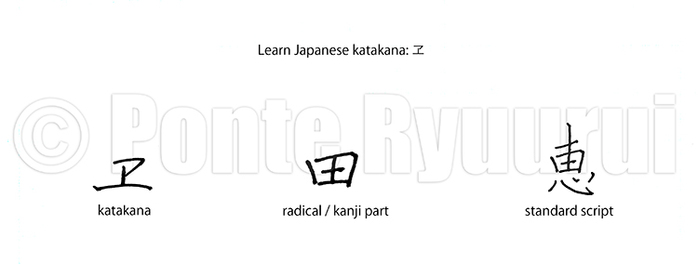 Japanese katakana syllabogram ヱ is derived from the simplified standard script (楷書) form of the Japanese kanji 惠 (blessing, grace), i.e. 恵. If you look at the diagram above, you will notice that the shape of katakana ヱ follows the general structure of the radical 田 (field), and it has the same stroke order. Although the shape of katakana syllabogram ヱ is different from the one of hiragana syllabogram ゑ, both syllabograms are based on the same Chinese character 恵. 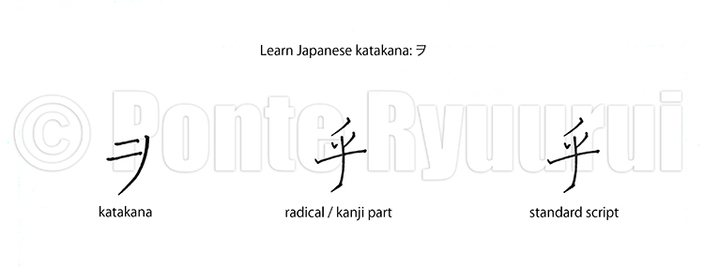 Japanese katakana syllabogram ヲ is derived from the standard script (楷書) form of the Japanese kanji 乎 (question mark). If you look at the diagram above, you will notice that the shape of katakana ヲ follows the general stgructure of the Chinese character 乎, but its stroke order differs slightly.  Japanese katakana syllabogram ヰ is derived from the standard script (楷書) form of the Japanese kanji 井 (a well). If you look at the diagram above, you will notice that the shape of katakana ヰ follows the general stgructure of the Chinese character 井, and it has the same stroke order.  Japanese katakana syllabogram ワ is derived from the standard script (楷書) form of the Japanese kanji 和 (harmony). If you look at the diagram above, you will notice that the shape of katakana ワ is similar to the one of the radical 口 (mouth, rutual vessel), and it has the same stroke order. Although the shape of katakana syllabogram ワ is different from the shape of hiragana syllabogram わ, both syllabograms are based on the same Japanese kanji 和. 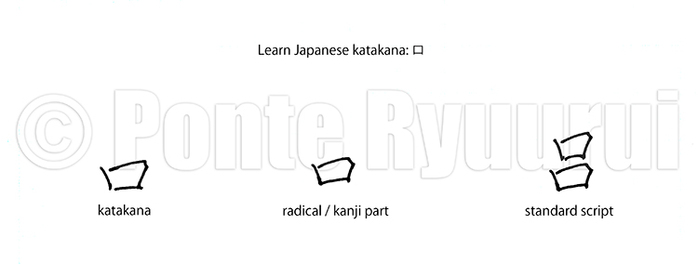 Japanese katakana syllabogram ロ is derived from the standard script (楷書) form of the Japanese kanji 呂 (spine, backbone). If you look at the diagram above, you will notice that the shape of katakana ロ is identical to the radical 口 (mouth, rutual vessel), and it has the same stroke order. Although the shape of katakana syllabogram ロ is different from the shape of hiragana syllabogram ろ, both syllabograms are based on the same Japanese kanji 呂.  Japanese katakana syllabogram レ is derived from the simplified standard script (楷書) form of the Japanese kanji 禮 (social customs, manners), i.e 礼. If you look at the diagram above, you will notice that the shape of katakana レ follows the central structure of the character 礼, and it has the same stroke order. Although the shape of katakana syllabogram レ is different from the shape of hiragana syllabogram れ both syllabograms are based on the same Japanese kanji 礼.  Japanese katakana syllabogram ル is derived from the standard script (楷書) form of the Japanese kanji 流 (to flow). If you look at the diagram above, you will notice that the shape of katakana ル follows the bottom part of the character 流, and has the same stroke order.  Japanese katakana syllabogram リ is derived from the standard script (楷書) form of the Japanese kanji 利 (advantage, benefit). If you look at the diagram above, you will notice that the shape of katakana リ is identical to the one of the sword radical (刂), and it has the same stroke order. Katakana syllabogram リ and the hiragana syllabogram り have very similar appearance.  Japanese katakana syllabogram ラ is derived from the standard script (楷書) form of the Japanese kanji 良 (good). If you look at the diagram above, you will notice that the shape of katakana ラ follows the top-right structure of the character 良, and it has the same stroke order. Although the shape of katakana syllabogram ラ is different from the shape of hiragana syllabogram ら, both syllabograms are based on the same Japanese kanji 良. 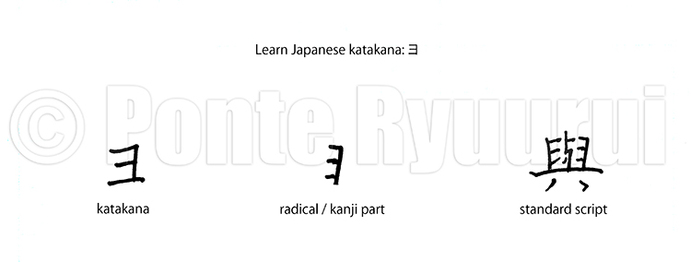 Japanese katakana syllabogram ヨ is derived from the standard script (楷書) form of the Japanese kanji 與 (participate in, give). If you look at the diagram above, you will notice that the shape of katakana ヨ follows the right-hand side part of the radical 𦥑 (milestone, mortar), and it has the same stroke order. Although the shape of katakana syllabogram ヨ is different from the shape of hiragana syllabogram よ both syllabograms are based on the same Japanese kanji 與.  Japanese katakana syllabogram ユ is derived from the standard script (楷書) form of the Japanese kanji 由 (reason). If you look at the diagram above, you will notice that the shape of katakana ユ follows the central structure of the character 由, but has a different stroke order. Although the shape of katakana syllabogram ユ is different from the shape of hiragana syllabogram ゆ both syllabograms are based on the same Japanese kanji 由.  Japanese katakana syllabogram ヤ is derived from the standard script (楷書) form of the Japanese kanji 也(to be). If you look at the diagram above, you will notice that the shape of katakana follows the central structure of the character 也, and it has the same stroke order Although the shape of katakana syllabogram ヤ is different from the shape of hiragana syllabogram や both syllabograms are based on the same Japanese kanji 也.  Japanese katakana syllabogram モ is derived from the standard script (楷書) form of the Japanese kanji 毛(hair, fur). If you look at the diagram above, you will notice that the shape of katakana モ is identical to the bottom part of the Chinese character モ, and it follows the same stroke order Although the shape of katakana syllabogram モ is different from the shape of hiragana syllabogram も, both syllabograms are based on the same Japanese kanji 毛.  Japanese katakana syllabogram メ is derived from the standard script (楷書) form of the Japanese kanji 女 (woman). If you look at the diagram above, you will notice that the shape of katakana メ follows the shape of of a small part of the second half of the first stroke, and the last stroke of the Chinese charatcer 女. The stroke order of メ is different that the one of the kanji 女. Although the shape of katakana syllabogram メ is different from the shape of hiragana syllabogram め both syllabograms are based on the same Japanese kanji 女.  Japanese katakana syllabogram ム is derived from the standard script (楷書) form of the Japanese kanji 矣 (sentence particle). If you look at the diagram above, you will notice that the shape of katakana ム is identical to the one of the radical 厶 (I, myself). Also, note that the hand written shape of the kanji 矣 misses one stroke. Hand written characters offen differ from their printed font counterparts. 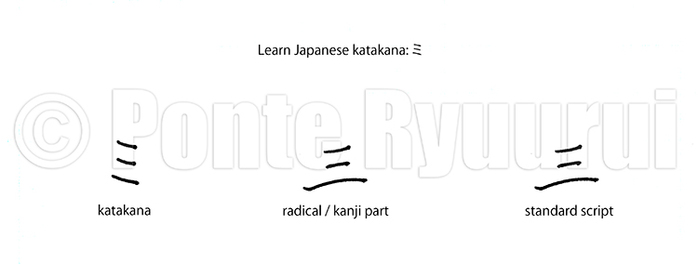 Japanese katakana syllabogram ミ is derived from the standard script (楷書) form of the Japanese kanji 三 (three). If you look at the diagram above, you will notice that the shape of katakana ミ is identical to the one of kanji 三, and has the same stroke order.  Japanese katakana syllabogram マ is derived from the standard script (楷書) form of the Japanese kanji 末 (top end, tip). If you look at the diagram above, you will notice that the shape of katakana マ follows the top part of the kanji 末. Although the shape of katakana syllabogram マ is different from the shape of hiragana syllabogram ま, both syllabograms are based on the same Japanese kanji 末.  Japanese katakana syllabogram ホ is derived from the standard script (楷書) form of the Japanese kanji 保 (protect, guarantee). If you look at the diagram above, you will notice that the shape of katakana ヒ is identical to the hand written shape of the radical 木 (tree), and follows the same stroke order Although the shape of katakana syllabogram ホ is different from the shape of hiragana syllabogram ほ, both syllabograms are based on the same Japanese kanji 保.  Japanese katakana syllabogram ヘ is derived from the standard script (楷書) form of the Japanese kanji 部 (section, department). If you look at the diagram above, you will notice that the shape of katakana ヘ follows the shape of the upper part of the radical 阝(right village radical). The stroke order of both is the same. and follows the same stroke order. The shape of the Japanese katakana syllabogram ヘ is virtually identical to the shape of hiragana syllabogram へ. Both syllabograms are also based on the same Japanese kanji 部.  Japanese katakana syllabogram フ is derived from the standard script (楷書) form of the Japanese kanji 不 (negative, un-, non-). If you look at the diagram above, you will notice that katakana フ follows the shape of the top part of the character 不 (first two strokes), and has the same stroke order. Although the shape of katakana syllabogram フ is different from the shape of hiragana syllabogram ふ, both syllabograms are based on the same Japanese kanji 不. |
Categories
All
AuthorPonte Ryuurui (品天龍涙) Archives
August 2020
|



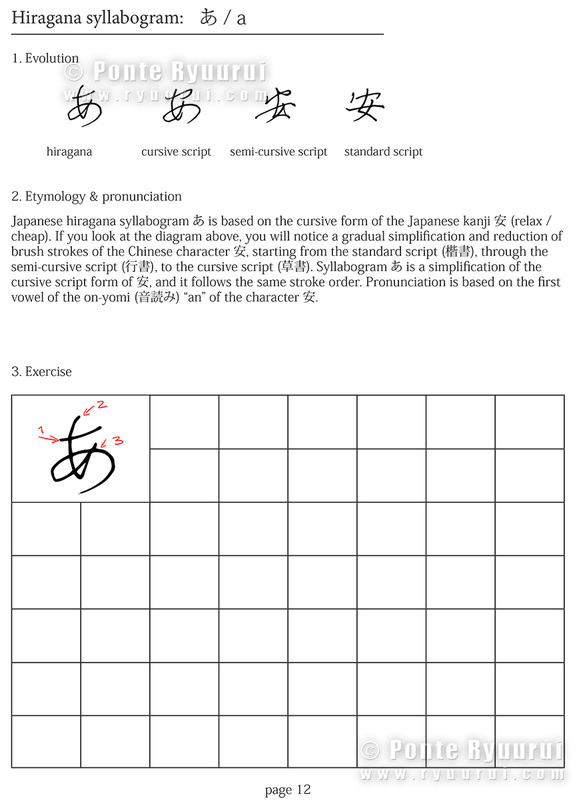

 RSS Feed
RSS Feed
